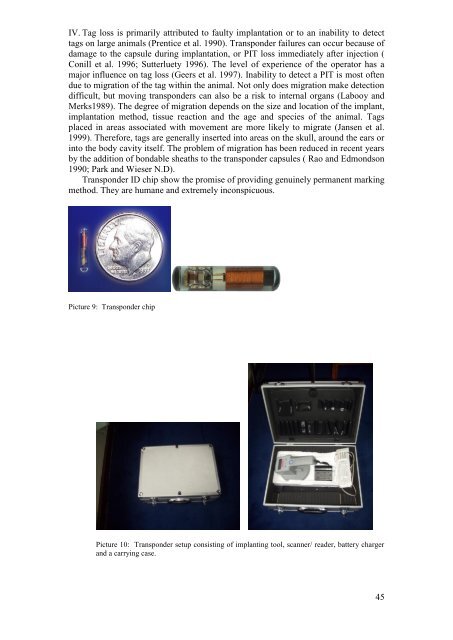standardization of records keeping in indian zoos - Central Zoo ...
standardization of records keeping in indian zoos - Central Zoo ...
standardization of records keeping in indian zoos - Central Zoo ...
You also want an ePaper? Increase the reach of your titles
YUMPU automatically turns print PDFs into web optimized ePapers that Google loves.
IV. Tag loss is primarily attributed to faulty implantation or to an <strong>in</strong>ability to detect<br />
tags on large animals (Prentice et al. 1990). Transponder failures can occur because <strong>of</strong><br />
damage to the capsule dur<strong>in</strong>g implantation, or PIT loss immediately after <strong>in</strong>jection (<br />
Conill et al. 1996; Sutterluety 1996). The level <strong>of</strong> experience <strong>of</strong> the operator has a<br />
major <strong>in</strong>fluence on tag loss (Geers et al. 1997). Inability to detect a PIT is most <strong>of</strong>ten<br />
due to migration <strong>of</strong> the tag with<strong>in</strong> the animal. Not only does migration make detection<br />
difficult, but mov<strong>in</strong>g transponders can also be a risk to <strong>in</strong>ternal organs (Labooy and<br />
Merks1989). The degree <strong>of</strong> migration depends on the size and location <strong>of</strong> the implant,<br />
implantation method, tissue reaction and the age and species <strong>of</strong> the animal. Tags<br />
placed <strong>in</strong> areas associated with movement are more likely to migrate (Jansen et al.<br />
1999). Therefore, tags are generally <strong>in</strong>serted <strong>in</strong>to areas on the skull, around the ears or<br />
<strong>in</strong>to the body cavity itself. The problem <strong>of</strong> migration has been reduced <strong>in</strong> recent years<br />
by the addition <strong>of</strong> bondable sheaths to the transponder capsules ( Rao and Edmondson<br />
1990; Park and Wieser N.D).<br />
Transponder ID chip show the promise <strong>of</strong> provid<strong>in</strong>g genu<strong>in</strong>ely permanent mark<strong>in</strong>g<br />
method. They are humane and extremely <strong>in</strong>conspicuous.<br />
Picture 9: Transponder chip<br />
Picture 10: Transponder setup consist<strong>in</strong>g <strong>of</strong> implant<strong>in</strong>g tool, scanner/ reader, battery charger<br />
and a carry<strong>in</strong>g case.<br />
45
















